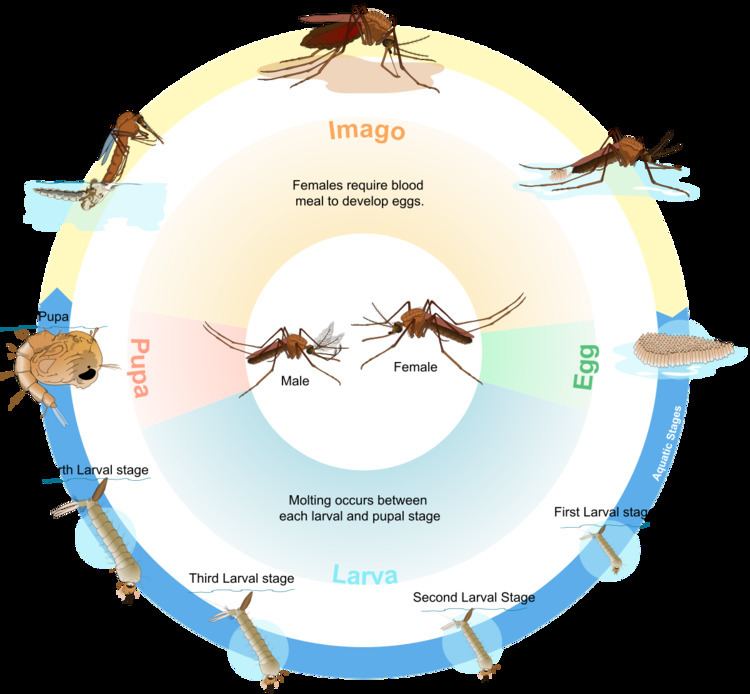 | ||
In biology, a biological life cycle (or just life cycle when the biological context is clear) is a series of changes in form that an organism undergoes, returning to the starting state. "The concept is closely related to those of the life history, development and ontogeny, but differs from them in stressing renewal." Transitions of form may involve growth, asexual reproduction, and/or sexual reproduction.
Contents
- Discovery
- Haplontic life cycle
- Diplontic life cycle
- Haplodiplontic life cycle
- Vegetative meiosis
- Evolution
- References
In some organisms, different "generations" of the species succeed each other during the life cycle. For plants and many algae, there are two multicellular stages, and the life cycle is referred to as alternation of generations. The term life history is often used, particularly for organisms such as the red algae which have three multicellular stages (or more), rather than two.
Life cycles that include sexual reproduction involve alternating haploid (n) and diploid (2n) stages, i.e., a change of ploidy is involved. To return from a diploid stage to a haploid stage, meiosis must occur. In regard to changes of ploidy, there are 3 types of cycles:
The cycles differ in when mitosis (growth) occurs. Zygotic meiosis and gametic meiosis have one mitotic stage: mitosis occurs during the n phase in zygotic meiosis and during the 2n phase in gametic meiosis. Therefore, zygotic and gametic meiosis are collectively termed haplobiontic (single mitotic phase, not to be confused with haplontic). Sporic meiosis, on the other hand, has mitosis in two stages, both the diploid and haploid stages, termed diplobiontic (not to be confused with diplontic).
Discovery
The study of reproduction and development in organisms was carried out by many botanists and zoologists.
Wilhelm Hofmeister demonstrated that alternation of generations is a feature that unites plants, and published this result in 1851 (see plant sexuality).
Some terms (haplobiont and diplobiont) used for the description of life cycles were proposed initially for algae by Nils Svedelius, and then became used for other organisms. Other terms (autogamy and gamontogamy) used in protist life cycles were introduced by Karl Gottlieb Grell. The description of the complex life cycles of various organisms contributed to the disproof of the ideas of spontaneous generation in the 1840s and 1850s.
Haplontic life cycle
A zygotic meiosis is a meiosis of a zygote immediately after karyogamy, which is the fusion of two cell nuclei. This way, the organism ends its diploid phase and produces several haploid cells. These cells divide mitotically to form either larger, multicellular individuals, or more haploid cells. Two opposite types of gametes (e.g., male and female) from these individuals or cells fuse to become a zygote.
In the whole cycle, zygotes are the only diploid cell; mitosis occurs only in the haploid phase.
The individuals or cells as a result of mitosis are haplonts, hence this life cycle is also called haplontic life cycle. Haplonts are:
Diplontic life cycle
In gametic meiosis, instead of immediately dividing meiotically to produce haploid cells, the zygote divides mitotically to produce a multicellular diploid individual or a group of more unicellular diploid cells. Cells from the diploid individuals then undergo meiosis to produce haploid cells or gametes. Haploid cells may divide again (by mitosis) to form more haploid cells, as in many yeasts, but the haploid phase is not the predominant life cycle phase. In most diplonts, mitosis occurs only in the diploid phase, i.e. gametes usually form quickly and fuse to produce diploid zygotes.
In the whole cycle, gametes are usually the only haploid cells, and mitosis usually occurs only in the diploid phase.
The diploid multicellular individual is a diplont, hence a gametic meiosis is also called a diplontic life cycle. Diplonts are:
Haplodiplontic life cycle
In sporic meiosis (also commonly known as intermediary meiosis), the zygote divides mitotically to produce a multicellular diploid sporophyte. The sporophyte creates spores via meiosis which also then divide mitotically producing haploid individuals called gametophytes. The gametophytes produce gametes via mitosis. In some plants the gametophyte is not only small-sized but also short-lived; in other plants and many algae, the gametophyte is the "dominant" stage of the life cycle.
Haplodiplonts are:
Some animals have a sex-determination system called haplodiploid, but this is not related to the haplodiplontic life cycle.
Vegetative meiosis
Some red algae (such as Bonnemaisonia and Lemanea) and green algae (such as Prasiola) have vegetative meiosis, also called somatic meiosis, which is a rare phenomenon. Vegetative meiosis can occur in haplodiplontic and also in diplontic life cycles. The gametophytes remain attached to and part of the sporophyte. Vegetative (non-reproductive) diploid cells undergo meiosis, generating vegetative haploid cells. These undergo many mitosis, and produces gametes.
A different phenomenon, called vegetative diploidization, a type of apomixis, occurs in some brown algae (e.g., Elachista stellaris). Cells in a haploid part of the plant spontaneously duplicate their chromosomes to produce diploid tissue.
Evolution
The primitive type of life cycle probably had haploid individuals with asexual reproduction. Bacteria and archaea exhibit a life cycle like this, and some eukaryotes apparently do too (e.g., Cryptophyta, Choanoflagellata, many Euglenozoa, many Amoebozoa, some red algae, some green algae, the imperfect fungi, some rotifers and many other groups, not necessarily haploid). However, these eukaryotes probably are not primitively asexual, but have lost their sexual reproduction, or it just was not observed yet. Many eukaryotes (including animals and plants) exhibit asexual reproduction, which may be facultative or obligate in the life cycle, with sexual reproduction occurring more or less frequently.
